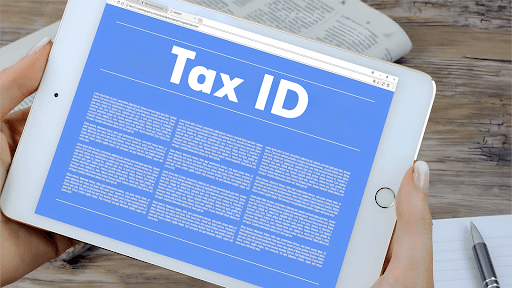
In the United States all individuals and business entities need to have a unique 9-digit identification number for the purposes of taxation. One cannot find work or start a company without a Taxpayer Identification Number (TIN). There are different types of TINs and understanding these identification numbers can be challenging.
This article serves as a guide for understanding these different Taxpayer Identification Numbers (TIN), Employer Identification Number (EIN), Social Security Number (SSN), equipping taxpayers with the knowledge to apply for tax exemption as allowed under each category.
What is a Taxpayer Identification Number (TIN)
Taxpayer Identification Number (TIN) is a unique number assigned to each taxpayer, tax preparer, or a business entity. As the foundation of tax administration, TIN serves as the primary identifier of taxpayers for government institutions in the United States. The Internal Revenue Service (IRS) uses TIN to track information about taxpayers in the country, and enforce the tax laws.
Types of TINs
The different types of TINs as per this Forbes article are:
- SSN (Social Security Number)
- EIN (Employer Identification Number)
- ITIN (Individual Taxpayer Identification Number)
- ATIN (Adoption Taxpayer Identification Number)
- PTIN (Preparer Taxpayer Identification Number)
More information on TINs can also be found in this article.
1. Social Security Number (SSN):
Social Security Number or SSN is a nine-digit identification number primarily for the taxpayers who are US Citizens. There are exceptions to non-citizens acquiring an SSN as explained in this Forbes article. In the United States, SSN is the most common TIN for individual taxpayers. It is used to report various sources of income like salary, freelance payments, tips, artwork commissions etc.
2. Employer Identification Number (EIN):
EIN is the unique identification for business entities, similar to an SSN for individuals. Each business entity operating in the US is assigned an EIN by the Federal Government. EIN is used by trusts, estates, and even non-profit entities for tax identification purposes. Businesses cannot operate without an EIN, which is needed to open a business bank account, hire employees, and file tax returns.
For example, Walmart has an EIN 71-0415188. This unique number allows the company to hire individuals and file for its tax returns.
Note that the other taxpayer identification types are relevant only in very specific situations. Detailing them is out of the scope of this article.
Use cases for Taxpayer Identification Numbers
TIN is useful for individuals, businesses, and even non-profit organizations.
Here are some key use cases of TIN:
Individuals:
TIN allows the IRS to track individual taxpayer’s filings. It can facilitate tax-related activities, such as filing tax returns, reporting income, claiming tax credits, and opening individual retirement accounts like IRA and 401k).
Businesses:
Businesses use EINs to file federal and state tax returns. In addition, EINs allow for paying payroll taxes, tracking business deductions, opening a bank account, and establishing licenses and permits.
Non-profit organizations:
Many non-profit organizations require tax returns using Form 990. EIN allows these organizations to report and pay taxes on income earned outside their mission. This way, non-profit organizations adhere to IRS guides and regulations using their unique tax ID.
What are exemption numbers?
Exemption numbers are unique identifiers that are found on exemption certificates. These certificates, issued by a government agency, verify that the holder is exempt from specific taxes if they meet all requirements.
As the definition suggests, it is “a number assigned by a state agency to identify the entity or organization as exempt from state sales taxes.”
Who qualifies for an exemption number?
In general, three categories qualify for an exemption number:
Non-profit organizations:
Organizations with a valid 501©(3) are generally exempt from federal income tax. Depending on the state and the organization’s purpose, they may be eligible for exemption certificates. These certificates exempt them from specific taxes, such as sales tax.
Government agencies:
Government agencies are often exempted from paying sales tax. This exemption is based on the legal principle that governments (federal, state, and local) generally should not tax each other’s activities. The Supremacy Clause supports this concept by ensuring that federal law prevails.
Educational institutions:
Public schools and some higher education institutions are exempt from paying sales tax. This exemption is for public educational institutions only because they operate under state and local governments, and it applies to qualified purchases made by the institutions to support their mission.
Benefits of using Tax ID or exemption number
Tax ID and exemption numbers offer many benefits to individuals and organizations.
TIN ensures accurate tax filing and reporting.
It acts as a unique identifier for the IRS, which reduces the risk of errors and delays in the process by properly linking the taxpayer’s information. A valid TIN also ensures compliance with tax regulations, including filing accurate tax returns, which helps avoid penalties and any complications during tax audits.
A correct tax ID helps avoid penalties and interest charges.
The IRS can impose penalties for errors on tax returns. These penalties can range from small fines to criminal charges. Therefore, a correct tax ID helps avoid these unnecessary costs.
EIN facilitates smooth business transactions.
A valid EIN on file allows businesses to open bank accounts, apply for permits, and obtain credit without problems. It also helps in establishing business credit for long-term financial planning.
How to obtain a tax ID
Obtaining a TIN is straightforward. The IRS suggests that a person or organization can apply for TIN via online application, fax, mail, and even telephone. These are briefed below, and a more detailed process can be found at this site.
Through the Internet
The Internet application for obtaining a tax ID is the most common and preferred method. Once the application is completed with valid information, TIN is immediately provided to the entity. The online application facility for a tax ID is available for all entities located in the US.
By Fax
Taxpayers can apply for a tax ID by faxing the completed Form SS-4. After ensuring that the form contains all the necessary information, a tax ID is issued by the IRS.
By Mail
If a fax facility is not available, taxpayers can also apply via mail. The applicant can mail the completed form to the IRS directly.
By Telephone
Lastly, international, authorized applicants can call the IRS to obtain their IDs.
Conclusion
Understanding tax IDs and exemption numbers is essential for every citizen. It empowers them to navigate the tax system efficiently and claim their benefits as well. With this general knowledge, they can ensure accurate tax filing, avoid penalties, and operate their business or non-profit organization with confidence.
